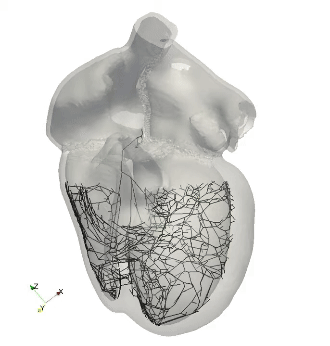 Electrical Activation of The Heart. SOURCE: https://ccl.medunigraz.at/ep_modeling.html
Electrical Activation of The Heart. SOURCE: https://ccl.medunigraz.at/ep_modeling.htmlAbstract
Atrial fibrillation (AF) is the most common heart arrhythmia, affecting millions worldwide. Diagnosis and treatment of AF often involves creating electro-anatomic activation maps, which represent the timing of tissue activation across the heart’s atria. Current mapping methods use interpolation techniques like linear or Gaussian process regression based on sparse electrode data collected within the atria. However, these techniques suffer from noise from electrode positioning and lack of prior physical knowledge of cardiac wave propagation, leading to suboptimal diagnostic accuracy. To address these challenges, we propose a physics-informed neural network (PINN) for cardiac activation mapping that incorporates the underlying wave propagation dynamics of cardiac electrical activity. Benchmarking against traditional interpolation and Gaussian process regression, the PINN model demonstrated improved diagnostic accuracy, paving the way for improved procedural efficiency and patient outcomes in atrial fibrillation diagnostics.
You can check the full paper, poster, and code of this research project from the buttons below.
Team Members
Mohamed GadMazen AtlamAnas ElsheikhSherif ElgendyAhmed Abdelghafar
References
This work is reproduction of “Sahli Costabal, F., Yang, Y., Perdikaris, P., Hurtado, D. E., & Kuhl, E. (2020). Physics-Informed Neural Networks for Cardiac Activation Mapping. Frontiers in Physics, 8. doi:10.3389/fphy.2020.00042” for learning purposes.
[1] “Correction to: Heart Disease and Stroke Statistics— 2018 Update: A Report From the American Heart Association”. In: Circulation 137.12 (2018), e493–e493. url: https://www.ahajournals.org/ doi/abs/10.1161/CIR.0000000000000573.
[2] Steven E Williams et al. “Local activation time sampling density for atrial tachycardia contact mapping: how much is enough?” In: EP Europace 20.2 (Apr. 2017), e11–e20. issn: 1099-5129. doi: 10.1093/europace/eux037.
[3] Sam Coveney et al. “Probabilistic Interpolation of Uncertain Local Activation Times on Human Atrial Manifolds”. In: IEEE Transactions on Biomedical Engineering 67.1 (2020), pp. 99–109. doi: 10.1109/TBME.2019.2908486.
[4] M. Mas`e and F. Ravelli. “Automatic reconstruction of activation and velocity maps from electroanatomic data by radial basis functions”. In: 2010 Annual International Conference of the IEEE Engineering in Medicine and Biology. 2010, pp. 2608– 2611. doi: 10.1109/IEMBS.2010.5626616.
[5] Vincent Jacquemet. “An eikonal-diffusion solver and its application to the interpolation and the simulation of reentrant cardiac activations”. In: Computer Methods and Programs in Biomedicine 108.2 (2012), pp. 548–558. issn: 0169-2607. doi: https://doi.org/10.1016/j.cmpb.2011.05. 003. url: https : / / www . sciencedirect . com / science/article/pii/S0169260711001180.
[6] Simone Pezzuto et al. “Evaluation of a Rapid Anisotropic Model for ECG Simulation”. English. In: Frontiers in physiology 8.MAY (May 2017). issn: 1664-042X. doi: 10 . 3389 / fphys . 2017 . 00265.
[7] P. Colli Franzone, L. Guerri, and S. Rovida. “Wavefront propagation in an activation model of the anisotropic cardiac tissue: asymptotic analysis and numerical simulations”. In: Journal of Mathematical Biology 28.2 (Feb. 1990), pp. 121–176. issn: 1432-1416. doi: 10.1007/BF00163143. url: https://doi.org/10.1007/BF00163143.
[8] Piero Colli Franzone and Luciano Guerri. “Spreading of excitation in 3-d models of the anisotropic cardiac tissue. I. validation of the eikonal model”. In: Mathematical Biosciences 113.2 (1993), pp. 145–209. issn: 0025-5564. doi: https: / / doi . org / 10 . 1016 / 0025 - 5564(93 ) 90001 - Q. url: https : / / www . sciencedirect . com / science/article/pii/002555649390001Q.
[9] Hubert Baty and L´eo Baty. “Solving differential equations using physics informed deep learning: a hand-on tutorial with benchmark tests”. working paper or preprint. Apr. 2023. url: https://hal. science/hal-04002928.
[10] M. Raissi, P. Perdikaris, and G.E. Karniadakis. “Physics-informed neural networks: A deep learning framework for solving forward and inverse problems involving nonlinear partial differential equations”. In: Journal of Computational Physics 378 (2019), pp. 686–707. issn: 0021-9991. doi: https://doi.org/10.1016/j.jcp.2018.10. 045. url: https : / / www . sciencedirect . com / science/article/pii/S0021999118307125.
[11] Mart´ın Abadi et al. TensorFlow: A system for large-scale machine learning. 2016. arXiv: 1605. 08695 [cs.DC]. url: https://arxiv.org/abs/ 1605.08695.
[12] Diederik P. Kingma and Jimmy Ba. Adam: A Method for Stochastic Optimization. 2017. arXiv: 1412.6980 [cs.LG]. url: https://arxiv.org/ abs/1412.6980.
[13] Michael Stein. “Large Sample Properties of Simulations Using Latin Hypercube Sampling”. In: Technometrics 29.2 (1987), pp. 143–151. doi: 10. 1080/00401706.1987.10488205. eprint: https: //www.tandfonline.com/doi/pdf/10.1080/ 00401706.1987.10488205. url: https://www. tandfonline.com/doi/abs/10.1080/00401706. 1987.10488205.
[14] Carl Edward Rasmussen and Christopher K. I. Williams. Gaussian Processes for Machine Learning. The MIT Press, Nov. 2005. isbn: 9780262256834. doi: 10.7551/mitpress/3206. 001 . 0001. url: https : / / doi . org / 10 . 7551 / mitpress/3206.001.0001.
[15] P. Perdikaris. Gaussian Processes: A Hands-on Tutorial. Available online at: https://github.com/ paraklas/GPTutorial. 2017.
[16] Francisco Sahli Costabal, Daniel E. Hurtado, and Ellen Kuhl. “Generating Purkinje networks in the human heart”. In: Journal of Biomechanics 49.12 (2016). Cardiovascular Biomechanics in Health and Disease, pp. 2455–2465. issn: 0021-9290. doi: https://doi.org/10.1016/j.jbiomech.2015. 12.025. url: https://www.sciencedirect.com/ science/article/pii/S0021929015007332. 6